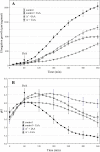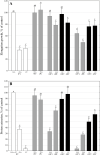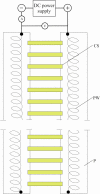The effect of DC electric field on the elongation growth, proton extrusion and membrane potential of Zea mays L. coleoptile cells; a laboratory study
- PMID: 35922781
- PMCID: PMC9347068
- DOI: 10.1186/s12870-022-03778-4
The effect of DC electric field on the elongation growth, proton extrusion and membrane potential of Zea mays L. coleoptile cells; a laboratory study
Abstract
Background: In this study, we investigated the effect of an electric field, with an intensity similar to that of the Earth's field, on plant cells growth. The molecular mechanism underlying this effect remains unclear.
Results: It was found that the electric field, depending on the applied voltage, its duration and the polarization of the maize seedlings, stimulated or inhibited the growth of the seedling organs (root, mesocotyl and coleoptile). Moreover, it was also noticed that the gravitropic response of maize seedlings was inhibited at all voltages studied. Simultaneous measurements of growth and external medium pH show that auxin(IAA, indole-3-acetic acid)- and fusicoccin(FC)-induced elongation growth and proton extrusion of maize coleoptile segments were significantly inhibited at higher voltages. The ionic current flowing through the single coleoptile segment during voltage application was 1.7-fold lower in segments treated with cation channel blocker tetraethylammonium chloride (TEA-Cl) and 1.4-fold higher with IAA compared to the control. The electrophysiological experiments show that the electric field caused the depolarization of the membrane potential of parenchymal coleoptile cells, which was not reversible over 120 min.
Conclusion: It is suggested that a DC electric field inhibits the plasma membrane H+ pump activity and K+ uptake through voltage-dependent, inwardly rectifying ZMK1 channels (Zea mays K+ channel 1). The data presented here are discussed, taking into account the "acid growth hypothesis" of the auxin action and the mechanism of gravitropic response induction.
Keywords: Coleoptile segments; Electric field; Elongation growth; External medium pH; Gravitropic response; Membrane potential; Zea mays L..
© 2022. The Author(s).
Conflict of interest statement
None.
Figures






Similar articles
-
Role of chloride ions in the promotion of auxin-induced growth of maize coleoptile segments.Ann Bot. 2014 Oct;114(5):1023-34. doi: 10.1093/aob/mcu170. Epub 2014 Aug 16. Ann Bot. 2014. PMID: 25129632 Free PMC article.
-
Effect of low frequency pulsed magnetic field on gravitropic response and cell elongation in coleoptiles of maize seedlings.Gen Physiol Biophys. 2016 Oct;35(4):417-424. doi: 10.4149/gpb_2016010. Epub 2016 Jul 22. Gen Physiol Biophys. 2016. PMID: 27447398
-
Fusicoccin (FC)-Induced Rapid Growth, Proton Extrusion and Membrane Potential Changes in Maize (Zea mays L.) Coleoptile Cells: Comparison to Auxin Responses.Int J Mol Sci. 2021 May 9;22(9):5017. doi: 10.3390/ijms22095017. Int J Mol Sci. 2021. PMID: 34065110 Free PMC article.
-
Effects of Naphthazarin (DHNQ) Combined with Lawsone (NQ-2-OH) or 1,4-Naphthoquinone (NQ) on the Auxin-Induced Growth of Zea mays L. Coleoptile Segments.Int J Mol Sci. 2019 Apr 11;20(7):1788. doi: 10.3390/ijms20071788. Int J Mol Sci. 2019. PMID: 30978914 Free PMC article.
-
Growth-limiting proteins in maize coleoptiles and the auxin-brassinosteroid hypothesis of mesocotyl elongation.Protoplasma. 2016 Jan;253(1):3-14. doi: 10.1007/s00709-015-0787-4. Epub 2015 Mar 15. Protoplasma. 2016. PMID: 25772679 Free PMC article. Review.
Cited by
-
Biowaste-Derived Triboelectric Nanogenerators for Emerging Bioelectronics.Adv Sci (Weinh). 2024 Nov;11(42):e2405666. doi: 10.1002/advs.202405666. Epub 2024 Sep 9. Adv Sci (Weinh). 2024. PMID: 39248387 Free PMC article. Review.
References
-
- Aplin KL, Harrison RG, Rycroft MJ. Planetary Atmospheric Electricity. New York, NY: Springer; 2008. Investigating Earth’s atmospheric electricity: a role model for planetary studies; pp. 11–27.
-
- Price C. Global surface temperatures and the atmospheric electrical circuit. Geophys Res Lett. 1993;20:1363–66. doi: 10.1029/93GL01774. - DOI
MeSH terms
Substances
LinkOut - more resources
Full Text Sources

